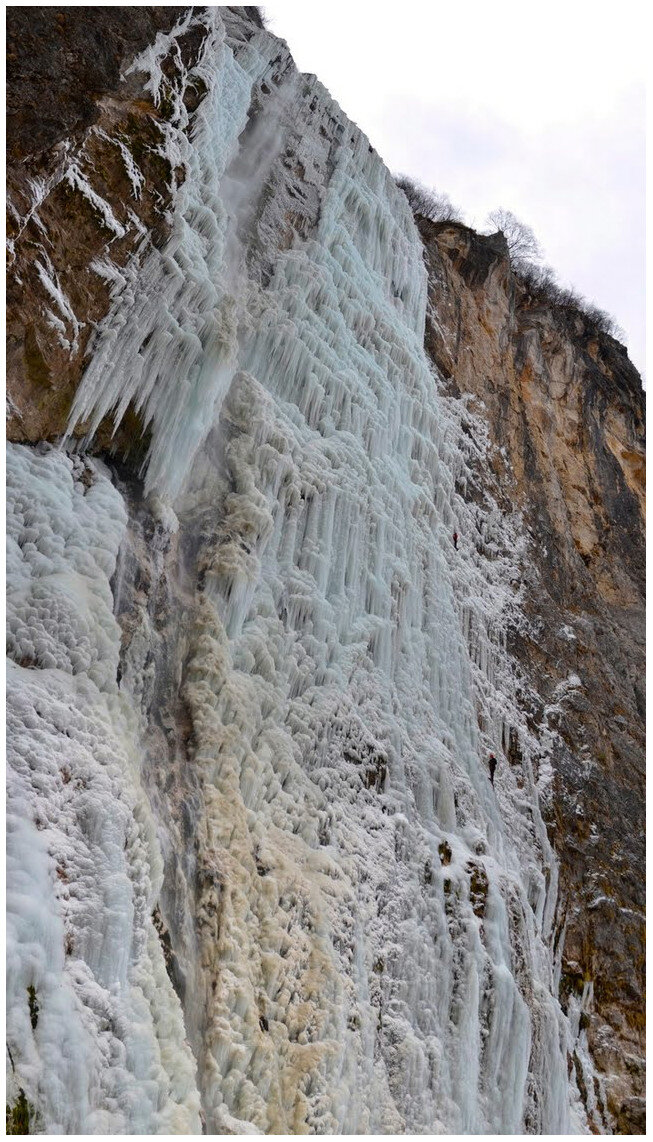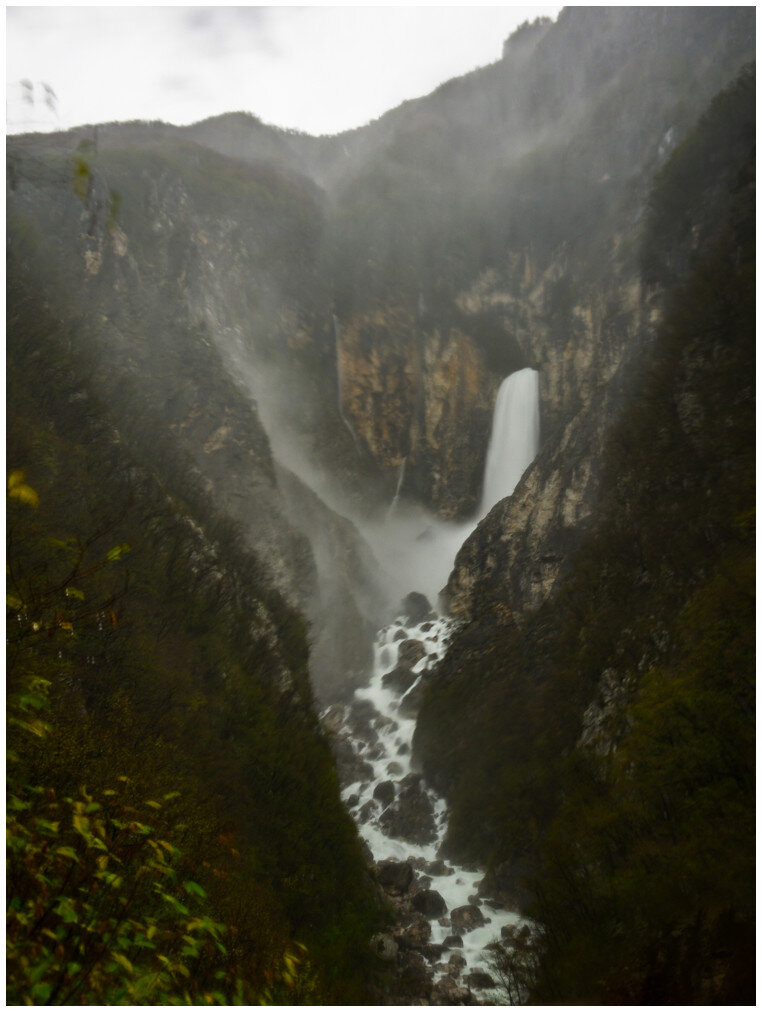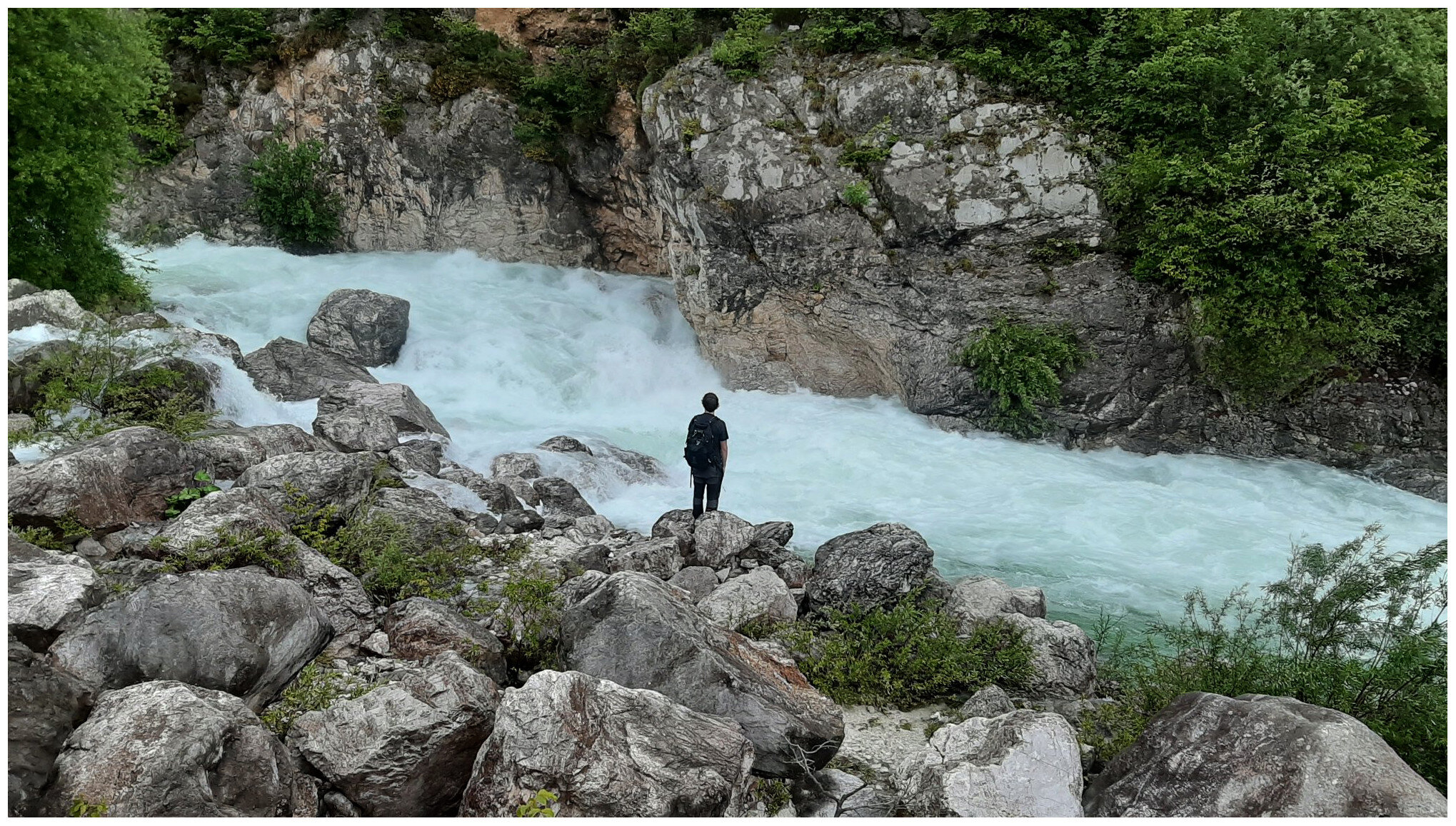Boka waterfall: The beauty and The beast
Kliknite tukaj za slovenski prevod vsebine bloga
Mirror, mirror on the wall, which is the mightiest of them all? If we are talking about the Soča Valley’s waterfall selection, Boka is the obvious answer. The waterfall is an impressive introduction to the Bovec valley, visible from the road connecting Kobarid to Bovec. Embedded into a rock wall, with its magnificent flow, and a vertical drop, the waterfall stimulates one’s imagination and hits the adventure nerve. No wonder there are so many stories built up around it.
Boka waterfall is full of superlatives. It is the one with the greatest water flows in Slovenia. If you want to see it in all its glory, Spring is the best time to visit. When the ice cracks and the snow starts to melt, the water drops down, forming a thundering water spectacle. Its water flow rate can reach up to 100m3/s. That is why Boka is also considered the most magnificent waterfall in the country. With its 106-meter Height and an 18-meter width, it is impossible to ignore it. Together with the lower shelf and its 30-meter drop, it scores a total height of 144m. Since this water hits the ground with such mighty power, it results in erosion. Therefore, Boka is actually gaining inches.
Two ways, two perspectives
When it’s big, it is an eye-catcher. You can admire the waterfall from the bridge that runs over the Boka stream. However, a closer look at this water beast is worth every sore muscle.
There are a few possible ways to get closer to the waterfall. Firstly, the shortest and most comfortable choice is on the Zaga side of the bridge.. A well-kept path takes you up to a wooden lookout point (15 min). From there, you can continue for an additional 40 minutes along an unofficial path. Is is steep and partially very exposed but gives you plenty of opportunities to peek at the waterfall. Once you arrive at an abandoned meadow, you turn right and stop. Standing on the edge of the rock wall, you are looking down on the entire waterfall.
There is a less talked about, but nicer alternative to reach the very same spot. The path starts in Žaga village, near the bridge and next to the restaurant Pri Mostu. It is less steep, marked and well-preserved (30 min).
The path to Boka from the Bovec side of the bridge brings you to its source (two hour hike). This is an even more demanding and adventurous choice. It is very steep, slippery and especially the last part of the walk can be dangerous. Pay special attention when stepping on the loose rocks and descending along the steel cable down to the lake on a rock shelf. The reward? A taste of 100% pure Boka water.
Thrill a minute!
When leaves start to fall off the trees, and green turns to white, Boka closes down its tourist season. Winter. Cold, wind and shade bind together in a longer, uninterrupted time period. These are the raw ingredients necessary for the waterfall to freeze. Due to mild winters, sun exposure, and relatively low position, Boka rarely blooms in ice. Therefore it seems like a miracle when the transformation happens.
Frozen Boka (foto archive: Dejan Koren)
Dejan Koren and Mitja Šorn (foto archive: Dejan Koren)
Ice climbing Boka (foto archive: Dejan Koren)
Slovenian climbers devoutly stared at the mighty Boka for years, honing their ice axes and waiting for the call. On January 5, 1993, climbers Slavko Svetičič and Silvij Černilogar broke the ice. They were the first ones to climb on top of the frozen Boka. Nineteen years later, the faith called up Mitja Šorn and Dejan Koren. It must be a surreal feeling, realising that the surface up which you've climbed was once, and will become again, a full flowing waterfall
The top of the waterfall is the endpoint for ice climbers. Several hundred meters above, on a rock ledge, the epic view triggers wingsuit base jumpers to take off. "What do you want to do when you grow up?" "Fly!" The mother imagined a pilot; the child became a flying squirrel. Who is a wingsuit base jumper? It is a person dressed in a squirrel-like suit jumping from cliffs, bridges, waterfalls and genuinely flying! The top of Boka is considered one of the technically more demanding wingsuit base exits. It is where the big birds fly.
Flying over the Boka waterfall (foto archive: Robert Pečnik)
Robert Pečnik and Ludovic Woerth were the first to jump from the top of Boka in 2011. They hiked up to the rock shelf at least three times, flirting with the idea of turning it into an exit. A rotting spruce tree in the middle of the ledge was the last obstacle holding them back. The axe cut the problem, the spruce fell, and the men jumped. Since then Robert did 320 jumps from Boka exit. Hiking, jumping, flying, landing. Repeat. The landing spot is on the right next to Žvikar restaurant. That is one way to make an entrance!
Behind the scenes
Climbing, jumping, what's next? Cave diving. The beautiful Boka waterfall, which flows out of the wall at an altitude of 725 meters, is just the tip of the iceberg. Tolmin cavers found an entrance to the Mala Boka cave near the foot of the falls. But this beautiful karst cave was just an introduction to the 8 km long cave system. With its hard-to-reach and still undiscovered abysses, it has been stirring local and foreign cavers for more than 30 years.
The long-sought upper entrance, abyss called BC4, was discovered by Polish cavers, in the high areas of the big Kanin mountains. But the local cave veterans were the ones who successfully connect the BC4 with the Mala Boka cave in the valley. They even managed to squeeze through the chocolate mud of the Nutella Killing narrow passage! The result was a 1319m deep cave system. On a snowy December day in 2005 three groups of cavers entered the BC4 at the altitude of 1730m. After 25 hours of climbing, descending and crawling, they came out 1300m lower. Mala Boka cave system thus ranked third on the scale of deepest caves in Slovenia.
Boka’s hidden dragons
A complete opposite to the waterfall’s dazzling beauty is a dark parallel world inside the mountain. The mysterious landscape gave cues to the fairy tales surrounding it. And there is no exciting story without a dragon.
The dragon illustration (Ristič 2011, 20)
Once upon a time, the life of people in the valley below Boka was difficult. A lot of hard work on the farm and too few helping hands. Parents of curious children wanted to keep them obedient and stay away from the gorges and caves around the valley. So they scared the kids with the legend of the seven-headed dragon. The beast was living in the nearby cave of Mt. Kopa. Since it was once full of rock pigeons, it was known as the Pigeon cave. It is hardly surprising that the pigeons disappeared, once they got a dragon for a roommate. The furious monster ravaged the surrounding slopes with his fire breath, and you can still see the imprints of his long claws on the surrounding riverbeds (Ristič 2011, 20).
Now you know that Boka waterfall has more to offer than just a chance to take a beautiful Instagram photo. When wandering around its mighty waters or hiking on the mountains above it, it is easy to fix your eyes on the captivating nature around you. But watch where you step! If you fall into one of the abysses here, you may well land a mile deeper. And nobody wants to wake up the seven-headed beast.











